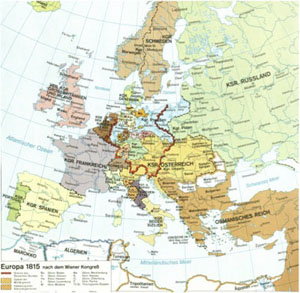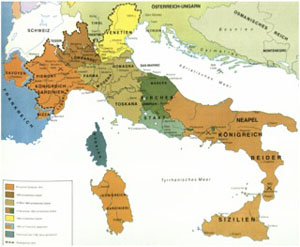3. Maps: Europe, Italy and Germany about 1815
Italy and Germany about 1815
Europe about 1815
 Click image to enlarge
Click image to enlarge
Questions
Geographical/Historical Context
During its deliberations in 1815, the Congress of Vienna disregarded all national and liberal demands. The Holy Roman Empire of the German Nation, dissolved in 1806, remained without a national successor state. The German Confederation, formed in Vienna, was a loosely organized confederation of 39 sovereign monarchies and free cities; it was meant to be indissoluble, yet it could only make decisions unanimously and had no own executive power at its command.
Italy remained divided in nine independent states which, with the exception of Sardinia-Piedmont, were ruled by foreign dynasties; according to Metternich, Italy was no more than a geographical term.
In the revolutions of 1848/49, the attempt to achieve national independence and unity “bottom-up” by means of national uprisings failed everywhere. The princely states suppressed the national movements, because they felt that these movements may pose threat to their territorial status and their constitutional system.
Answers to the questions
1. Compare the political structure of Germany and Italy on the historical maps (map 1 and 2). What obstacles does the multitude of dominions and states pose?
Both territories are divided in bigger and smaller states/kingdoms -> there is no unitary national territory; territories such as the Hapsburg empire only partially belong to a larger political unit -> there is hardly any concordance between political and linguistic/cultural areas
2. What are the differences visible when comparing Germany and Italy to countries like France and England (map 3)?
France and England have a coherent, unitary national territory and a centralized government which is thus both strong and assertive.





